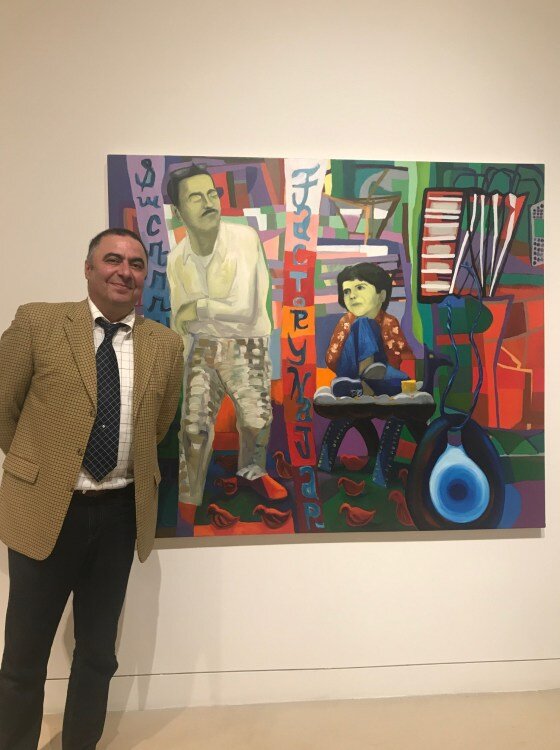https://artandcakela.com/2019/12/21/adjacent-adjacent-at-torrance-art-museum/
Adjacent, Adjacent: Multi-Curated Innovation
Torrance Art Museum
Hagop Najarian. Adjacent, Adjacent. Torrance Art Museum. Photo Credit Genie Davis
by Genie Davis
Adjacent, Adjacent, at the Torrance Art Museum through December 21st, is a vibrant, lively, exciting communication between works that serve as the culmination of TAM’s Forum 2019. The Forum itself is a participatory ten-month collaborative residency made up of 14 artists.
Non-thematic, and curated by collaborative residency participants, Henderson Blumer, Kim Marra, Hagop Najarian, Larissa Nickel, and Surge Witron, the exhibit is electrically exciting in and of itself.
Each of the artists has something fresh and engaging to impart; the curators have managed to coalesce this diverse group of images into a stellar show that engages the eye and the mind.
Exhibiting artists include Amoral Poem (Devion Law & Joshua Ross), Christina Shurts, Dakota Noot, H. Leslie Foster II, Hagop Najarian, Henderson Blumer, Jen Vanegas Rocha, Joshua Vasquez, Kim Garcia, Kim Marra, Larissa Nickel, Molly Schulman, Surge Witrön, Sharon Levy.
For the viewer, the exhibition feels as if it were “adjacent” to something only just barely imagined, an intersection of fantasy and reality. Highly contemporary in style, the range of mediums and color palettes works well together, highlighting adjacency in another way: each work is different than, but adjacent to, the next. The underlying message seems deceptively simple: step inside the museum and explore.
Especially striking, Molly Schulman’s “Cursed,” are motorized, battery-operated plastic hands that were spinning around the gallery floor during the opening. The movements themselves were eye-catching, of course, but the hands, which resemble bold Mickey Mouse-style white gloves were simply terrific, both due to their motion and their amusing yet somehow ominous finger pointing and gestures.
Sharon Levy’s glowing “Smog, Sunset” which evoked a familiar view down La Brea Ave., was created with acrylic paint, muslin, wood, and LED lights. It was like a living, breathing piece of cinema conjoined with painterly art; the color of the piece transitioned depending on how near or far the viewer was to it.
Hagop Najarian’s figurative oil on canvas “Factory Najar 1969-2019” is both memory piece and dream; the artist has indicated that his work is a response to various musical genres, and there is within the work a sense of rhythm and light, images that even actually recall the patterns of musical notes.
Dakota Noot’s wonderfully dark, whimsical, and enchanted acrylic painting is a dazzling creature with a bright palette rich with pinks, blues, and golds. With five human hands and three human legs, two of which make up the horned beast’s antlers, the work is one-hundred-percent magical.
Likewise vivid, Surge Witron’s “Flaming Hot Cheetos” is a dazzling mix of spray paint, graphite, and Yupo paper; Kim Marra’s vibrant geometric oil paintings play off Witron’s more chaotic approach.
Kim Garcia’s large scale “all things inside” is a strange fruit or fraught anchor of Forton, acrylic paint, polyurethane foam, and rope.
Larissa Nickel’s mesmerizing “En Passant” uses a reflective chrome mirror to interact with the museum space and its visitors, at least “in passing,” as its name – and reference to a specialized chess move – suggests. The artist’s other works in the exhibit, based around a collection of lace doilies, is a fascinating use of textiles and sculptural forms.
The Forum itself that birthed this show is an annual mentorship program, which TAM director and head curator Max Presneill describes as “looking for people with enough experience to understand the goals of the program and how to take advantage of them and what the expectations are, but with not so much experience that we aren’t offering anything.” The group, once selected, meets once a month at the museum, where they talk with different art professionals including critics, curators, and gallerists.
“Forum members can ask any questions they want and spend time in the meetings, and form the basis of relationships within the group. There are expectations that people take on roles in the group.” Presneill notes that each applicant applied as a writer or curator or an artist. “We encourage them to be all of those things, so they can get experience doing them. During the program, they all develop their own show, working as curators, writing essays, organizing the logical elements such as collecting and delivering work, getting information to the museum to print exhibit labels, and getting images on the website for the museum. It’s all encompassing,” he notes.
The exhibition runs for several weeks, and while it is important – and a terrific experience for gallery attendees – Presneill explains that the true value of the mentorship program “is not in the exhibition, but in the relationships that the group forms, that kind of supportive sense of community they can move forward with in the future, help each other out, offer moral support and a knowledge base, particularly as their careers develop.”
TAM is also “highly encouraging” of the cohort developing a collaborative alternative artists group so they can function together in terms of exchanges, acting as a cohesive group going forward. A number of those exhibiting in this show will continue their working relationships through an art collective titled Museum Adjacent.
“There really is power in that type of group, particularly when you work together to get new opportunities,” Presneill attests.
The deadline to apply for each Forum program is January; interviews take place in February, and the courses start in March. Besides putting the mentorship together, Presneill notes that “the only part we play in the actual exhibition is the installation, working with the group in hanging the show. We have no say in the selected works, and the curation is all down to the group themselves. They deserve all the credit for what is in front of the public.”
In terms of Adjacent, Adjacent, much credit is due, indeed.

